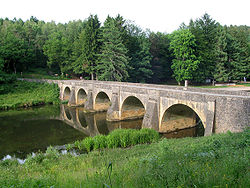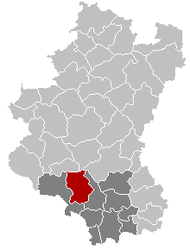- Chiny
-
For the Polish village, see Chiny, Pomeranian Voivodeship.
Chiny Chiny: St Nicholas's bridge on the River Semois 
Coat of armsLocation in Belgium Coordinates: 49°44.3′N 05°20.6′E / 49.7383°N 5.3433°E Country Belgium Region Walloon Region Community French Community Province Luxembourg Arrondissement Virton Government - Mayor Sébastian Pirlot (Député) - Governing party/ies Député Area - Total 113.69 km2 (43.9 sq mi) Population (1 January 2010)[1] - Total 5,170 - Density 45.5/km2 (117.8/sq mi) Postal codes 6810-6813 Area codes 061 Website www.chiny.be Chiny is a Walloon municipality of Belgium located in the province of Luxembourg.
On 1 January 2007 the municipality, which covers 113.69 km2 (43.90 sq mi), had 5,021 inhabitants, giving a population density of 44.2 inhabitants per km². It comprises six villages:
- Chiny proper
- Izel
- Jamoigne
- Les Bulles
- Suxy
- Termes
Chiny is located on the boundary between the geographical regions of the Gaume and the Ardennes.
The name Chiny also refers historically to a former county, larger than the current municipality.
The blazon of the municipality is: azur three fish argent surmounted by a crown (three silver fish and a golden crown on a blue field).
Contents
History of the Counts of Chiny
The first dynasty ruled from 980 to 1384.
From 980, Arnoul of Burgundy-Granson, a descendant of Charlemagne, became the first Count of Chiny. By his marriage to Mathilde, daughter of Ricuin, Duke of Mosellane and Count of Ardennes, he acquired the dowry of his wife, a land of forests rich with game, crossed by a capricious river, the Semois. His son Othon of Warcq, left his small fortress on the Meuse to site the Chateau de Chiny on a rocky spur overlooking the river. In the eleventh century, the Chateau was a formidable barrier in the region. The area that was ruled by the count was huge: 246 towns, 57 castles, 1412 villages.
The fourth Count, Louis II, loved hunting parties and held them in his huge game park starting in 1040. It was then that the legend relates that a young lord named Thibault, a descendant of the Counts of Champagne, secretly left his father's house to offer his services in the Ardennes forest near Chiny, where he established a hermitage and found a source of holy springs. Louis II built a large shrine to the spring's healing powers. The shrine became famous, with many pilgrims who came to implore the grace of Saint-Thibault. Later, monks from Calabria, Italy, founded a Monastery nearby at Orval.
Arnoul, a successor, regularly confronted Count Godfrey of Bouillon, leader of the first Crusade and nephew of Queen Mathilde. They eventually became friends and Arnoul entrusted Godfrey both his sons, Otto and Louis, to take part in the first Crusade. Returning from the Crusade, Otto, was in turn count of Chiny, but he found Orval falling in ruins. The Calabrian monks left in 1108, and the Cistercians revived Orval.
Louis IV was the last count of the first dynasty. Having no son, he prepared Jeanne, his eldest daughter, as his successor. Louis IV marked his reign by the first postage stamp in the county.
In marrying Jeanne, Arnulf of Looz became the first Count of the second dynasty. He was notable as the builder of the fortress of Montmedy. Their son, Louis V held a tournament of chivalry in 1285 that was regarded as the finest in the Middle Ages, at the village de Chauvency-le-Château. Over 500 knights of Europe attended this tournament and were memorialized in song by the bard Jacques Bretel. Louis V enjoyed great notoriety as a result. He died in 1299. His heart, per his last wishes, was embalmed and buried in a lead box in front of the altar at Saint-Thibault, in the village of Suxy.
Thereafter, the Counts struggled to maintain their territory as wars and battles ensued. They were by turn, the vassals of the Count of Bar, John the Blind, King of Bohemia and Duke of Luxembourg, all claiming the same lands. Seven Counts were named in less than thirty years. The father of Arnould Rumigny, last count of Chiny died of pneumonia a few months before the birth of his son. His young widow died in childbirth, and the son, Arnould, sold his lands rather than allow his malevolent uncle's offspring to inherit. On 13 June 1364, the lands of Chiny were sold to Wenceslas, Duke of Luxembourg.
Later, in the 15th century, the Count de Faing was created and his Chateau was erected, which was later reconstructed and stands today.
See also
- List of the Counts of Chiny (French)
- History of the Counts of Chiny (French)
References
- ^ Population per municipality on 1 January 2010 (XLS; 221 KB)
External links
Arlon 
Bastogne Marche-en-Famenne Durbuy · Erezée · Hotton · La Roche-en-Ardenne · Manhay · Marche-en-Famenne · Nassogne · Rendeux · TennevilleNeufchâteau Bertrix · Bouillon · Daverdisse · Herbeumont · Léglise · Libin · Libramont-Chevigny · Neufchâteau · Paliseul · Saint-Hubert · Tellin · WellinVirton Chiny · Étalle · Florenville · Habay · Meix-devant-Virton · Musson · Rouvroy · Saint-Léger · Tintigny · VirtonCategories:- Municipalities of Luxembourg (Belgium)
Wikimedia Foundation. 2010.



